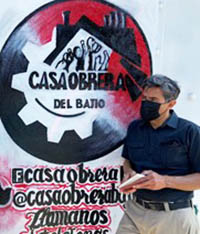|
|
|
|
The weekly newsletter of the México Solidarity Project |
|
|
|
January 12, 2022/ This week's issue/ Meizhu Lui, for the editorial team |
|
|
The Seed and the Hope, Chiapas, Antonio Turok, 1983 |
|
Promising Seeds of Hope for Mexican Workers |
|
As a child, did you ever blow milkweed seeds — with their silky parachutes — up into the air and make a wish? Watching seeds soar away on a current of wind, imagining their journey to parts unknown, has always filled young hearts with excitement and hope.
Mexican workers, here in 2022, can feel that excitement and hope. México’s new labor laws have now rolled out all across the country. These laws set up impartial federal labor courts to oversee labor disputes. The rollout took three years. The impact will be far-reaching.
Before this labor law reform — a direct result of Morena’s triumph in México’s 2018 elections — neoliberal PRI party state governors pulled the labor relations strings, in an unholy trinity with employers and corrupt charro “unions.” Now things are changing, nowhere more so than at the huge General Motors plant in Silao, Guanajuato.
Workers there have overturned a charro contract that provided ample protection for GM’s interests but did precious little for workers. Rank-and-filers at the plant have formed their own union and elected Alejandra Morales Reynosa their general secretary. In this week’s issue, we interview this dynamic new labor leader. In the face of machismo, her election exemplifies the inclusive democratic culture inside SINTTIA, the independent new Mexican union now organizing to officially represent Silao’s GM workers.
SINTTIA has big dreams. Starting with zero resources, with not enough money to even buy a ream of paper, SINTTIA is facing down an entrenched union with pesos aplenty and an arsenal of tools to bribe and intimidate. SINTTIA’s long-term goal: to organize the entire auto industry in México. What confidence, what hope!
A wing and a prayer: Yes, seeds can soar, but they can only survive and thrive if they take root in solid ground. Our México Solidarity Project has joined the folks at Labor Notes — the media and organizing project that’s working to put the movement back in the labor movement — to raise the funds that can help SINTTIA take root and soar into México’s future. A SINTTIA victory in the upcoming GM Silao representational election could give new inspiration to an independent Mexican union movement!
|
|
|
|
Your support can make a critical difference to México’s emerging democratic, independent labor movement. Please help make SINTTIA’s wish for a worker-led union come true. Donate whatever you can to the drive for $10,000 in material support for SINTTIA. The Yankee dollar goes a long way! |
|
|
|
|
A New Confidence: ‘We Have What GM Doesn’t Have’ |
|
Alejandra Morales Reynoso is currently serving as the general secretary of SINTTIA, the independent union now organizing to gain official bargaining rights for auto workers at GM's huge Silao plant in central México. A single mother with one child, she works full-time at that plant and shoulders the responsibilities of leading her new union, the Sindicato Independiente Nacional de Trabajadoras y Trabajadores de la Industria Automotriz. Morales Reynoso’s administrative skills have impressed her fellow workers. Her courage and determination have earned their trust.
Why did you become a rank-and-file organizer in the campaign to replace the CTM union that used to represent GM workers in Silao? |
|
|
I’ve been working on the line at GM since 2010, and right now I’m a painter of the Sierra and Cheyenne trucks that we produce. About 7,000 workers here in Silao work in two 12-hour shifts, four days — or nights — a week. We churn out 65 vehicles an hour. One hundred percent of the vehicles go for export, mostly to the US.
Our pay, for working in tough conditions on the line, amounts to the equivalent of US $2 an hour. We can’t afford cars. We rely on public and GM bus transportation.
After years of seeing all this injustice, I had to do something. The representative from the former CTM union used to tell me, “Stay out of our union!” They weren’t interested in protecting workers. I realized that we needed our own independent union to fight for better working conditions, better salaries, and to keep the bosses from harassing and threatening us.
As a woman working at GM, what problems do you face?
At GM, 35 percent of all the workers are women, and, yes, we face discrimination from the bosses and sometimes from men on the line. The machismo outside doesn’t stop at the plant gates. Most of the women who work here have children, and getting time off when a child comes down sick, or during pregnancy, can be difficult or impossible.
You were elected general secretary of the independent union SINTTIA. How do you balance family time and union responsibilities while working 48 hours a week?
First of all, I feel honored to have been elected by my fellow workers. And it’s true that life isn’t easy, especially when you’re poor and have kids. We know that US auto workers own cars. Why can’t we be paid enough to own a car? Some of us can hardly pay the rent, and our houses don’t even have sewage! We know that the GM millionaires with their mansions and big cars could easily pay us well. Organizing for our union gives me strength. It would be selfish not to talk openly about what SINTTIA can do for us if we stick together. There’s so much to do!
Does your work for SINTTIA put you at risk of being forced to resign, something that’s happened to other workers who’ve dared to organize against the CTM and GM?
It’s possible, but I’m less likely to be fired now because management knows where I stand and that I have support. SINTTIA was only just formed last July. Our membership still remains small, but many workers who aren’t members yet quietly support us. And many who voted against ending the contract with the charro CTM now support SINTTIA and aren’t as afraid about losing their jobs. This shows that we’re getting stronger! |
|
Because we’re new, SINTTIA has practically no resources. But through the support of CILAS — the Centro de Investigación Laboral y Asesoría Sindical in México City, a group that aids workers — we now have our own worker center, the Casa Obrera, where we can meet and plan, offer support to workers, and sharpen our organizing skills.
The historic vote to end the CTM contract at GM Silao took place last August. When will the election to choose a new union take place and what opposition does SINTTIA face? |
|
|
We don’t know yet when we’ll have a date for the vote. That’s up to labor officials to decide. Inside the plant, activists with Generando Movimiento — our worker organization — talk with the compañeros on the line all the time. |
|
We know that we’re always being watched by management and supporters of the former CTM union. The CTM is hoping to divide the workers by promoting small so-called “unions” of their own creation. One example of this tactic would be the SITEAAA.
What support does your movement at the Silao plant have in the community? |
|
|
We both give and receive support. For example, two years ago young students and feminists organized a strike at the University of Guanajuato to denounce men accused of sexual attacks against women. Members of our Generando Movimiento went to the students to offer moral support.
Since the “no” vote against CTM at GM Silao, automotive industry unions and other labor organizations from several countries have sent us letters of support. We’re working hard to build awareness of our fight for justice and a decent contract. We know how critical the support we can get from community organizations, students, and the church will be for our union. It’s not going to be easy to win, but we have what GM doesn’t have: unity! |
|
|
|
Don’t miss an issue. Subscribe to the weekly México Solidarity Bulletin! |
|
|
‘The End of Silence’: The Photographs of Antonio Turok |
|
With this week’s issue, we’re debuting a new culture column that we’ll be running once a month here in our México Solidarity Bulletin. The artist Tina Modotti’s iconic image of a Mexicana freedom-flag bearer captures our intent to fill this Expressions space with art and culture that serves social transformation. |
|
|
For this first Expressions, we’re highlighting the work of famed photographer Antonio Turok, the focus of an exhibition this past fall put together by the Eastern Projects Gallery in Los Angeles. This exhibition showcased Turok’s life-long effort to depict the turbulent history of México’s indigenous and mestizo communities. We excerpt here a Jimmy Centeno review of that exhibition, The End of Silence. |
|
Upon the signing of the North American Free Trade Agreement, the Zapatista 1994 uprising in Chiapas, Mexico drew the world’s attention to the perverse logic of domination by a modern colonial world system against people from the Global South… The Zapatista un proyecto de vida against los malos goviernos is sealed in many of Turok’s images. He captures the solidarity muscle behind the rebel group. |
|
Turok’s medium of choice of black and white photography glares out the distraction that comes with color photography. It allows him to remove the blinders to the rawness of the present world order. |
|
|
Mujeres Zapatistas, 1994, Antonio Turok |
|
The silver emulsion in Turok’s black-and-white photography, unlike digital, carries the mystic silver rays of Tonanzin, the moon goddess of Mesoamerica. It is what allows his work to glow out of darkness… |
|
Turok carries with him the spilled blood and the dust of hope. Every so often he releases the energy of these photographs in spaces known as galleries and museums as a soul cleansing ritual for all to engage in. The energy as resurrection then walks among the living, whispering their unknown stories… |
|
|
Entrance of the Ejercito Zapatista, Chiapas, 1994 |
|
The silent co-authors of The End of Silence do not ask for anything. They fight for what is owed to them: dignity, justice, and peace. They fight against the very same system and people who have deemed them as backward cultures and useless for modernity. |
|
|
Recent news reports and commentaries, from progressive and mainstream media,
Legitimating Collective Bargaining Agreements In Mexico: What Have We Learned To Date? Maquila Solidarity Network. All existing collective bargaining agreements in México must now win the approval of the workers the CBAs cover by May 1, 2023. The new briefing paper focuses on the first two years of this approval-vote process.
Cintia Martínez Velasco, El femi-geno-cidio y el trabajo de maquilas en México, Jacobin America Latina. Pero existe un tipo de feminicidio no tan fácil de reconocer: el feminicidio social o encubierto, que incluye formas no explícitas de asesinato de mujeres y se produce cuando se permite su muerte a causa de actitudes o instituciones sociales misóginas.
Anthony Harrup, Bank of México Plans to Launch Digital Currency by 2024, Wall Street Journal. México’s central bank has warned against the risks of bitcoin and other private cryptocurrencies. But officials have been open to central-bank digital currencies as a way, says AMLO, “to advance financial inclusion” in an economy that relies on cash for most transactions.
Nick Corbishley, México City Grapples With Acute Water Shortages, Naked Capitalism. One of the world’s largest cities could face ‘Day Zero’ — when supplies of water run so low that government must begin rationing the precious liquid — as early as 2028.
Mary Beth Sheridan and Alejandra Ibarra Chaoul, In coronavirus-hit Mexico, many women are ‘determined to not have babies,’ Washington Post. Birth rates have dropped dramatically in México since 2019.
Fabiola Martínez y Enrique Méndez, Difícil de saber cuánto durará “Permanece en México”: Ebrard, La Jornada. Estados Unidos está enviando a diario a México a poco más de mil 500 personas.
Nacha Cattan, México's Record Remittances Are Helping to Prevent Consumer Crisis, AMLO Says, Bloomberg News. Transfers sent to Mexico rose 27 percent in 2021 from the previous 12 months. |
|
|
The Mexico Solidarity Project brings together activists from various socialist and left organizations and individuals committed to worker and global justice who see the 2018 election of Andrés Manuel López Obrador as president of México as a watershed moment. AMLO and his progressive Morena party aim to end generations of corruption, impoverishment, and subservience to US interests. Our Project supports not just Morena, but all Mexicans struggling for basic rights, and opposes US efforts to undermine organizing and México’s national sovereignty.
Editorial committee: Meizhu Lui, Bruce Hobson, Bill Gallegos, Sam Pizzigati, Courtney Childs, Victoria Hamlin. To give feedback or get involved, drop us an email! |
|
|
|
Web page and application support for the México Solidarity Project from NOVA Web Development, a democratically run, worker-owned and operated cooperative focused on developing free software tools for progressive organizations. |











